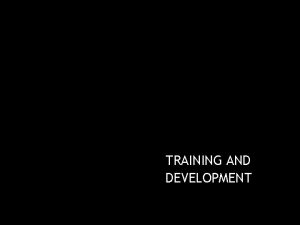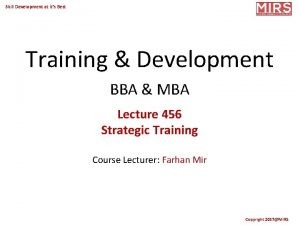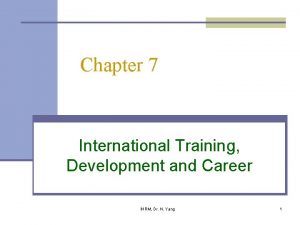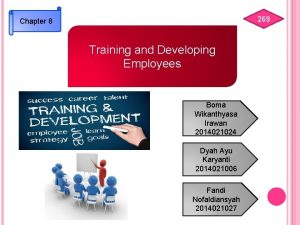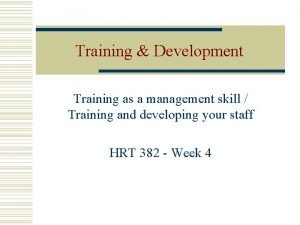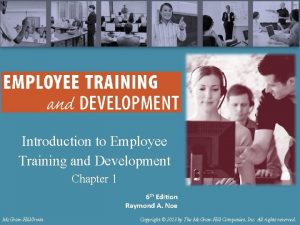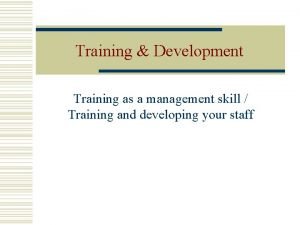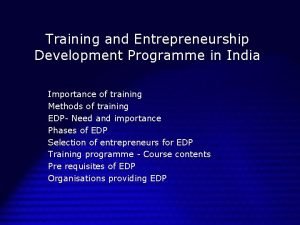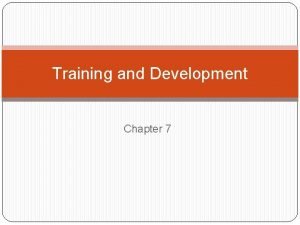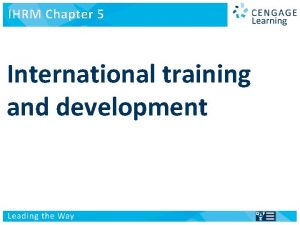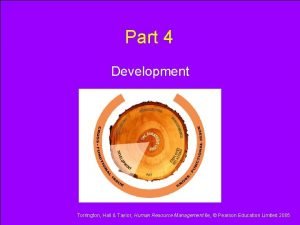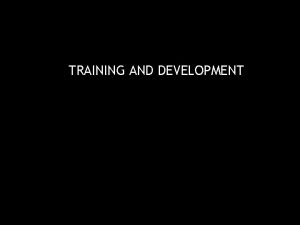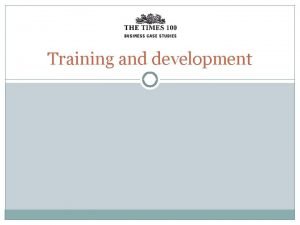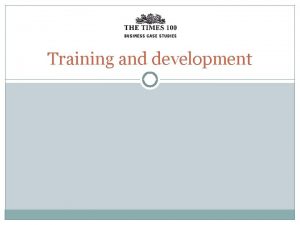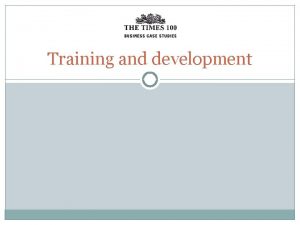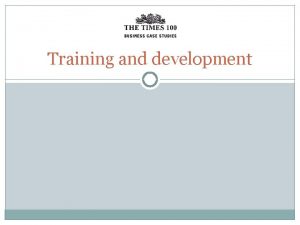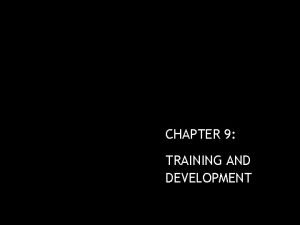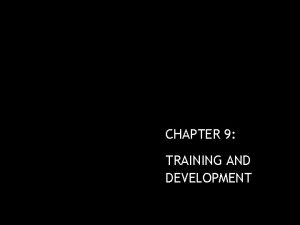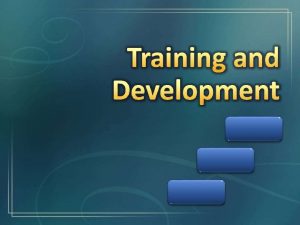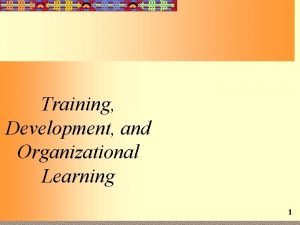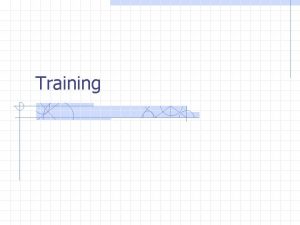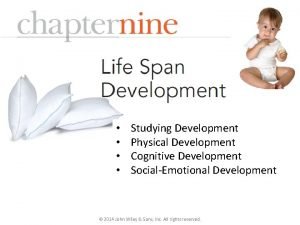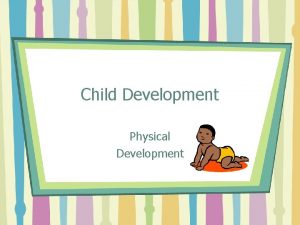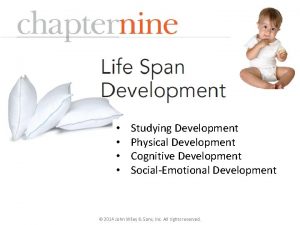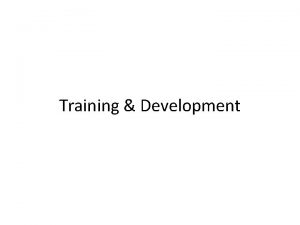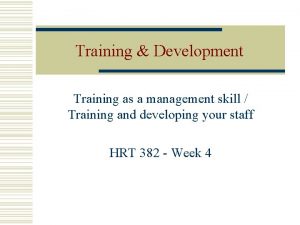TRAINING AND DEVELOPMENT Training Development Training development Training




















- Slides: 20

TRAINING AND DEVELOPMENT

Training & Development • Training & development – Training is the process of teaching the employees the skills and knowledge they need to do the job. 1– 2

Importance of training & development – Rapid technological changes cause skill obsolescence – Redesign of work brings need for new skills – Mergers & acquisitions have increased need for integrating employees into different cultures – Employees are moving between employers more often, necessitating training – Globalization of business requires new knowledge & skills – Where an employers fail to train and employee does harm to third parties, the court will find the employer liable – Developing and transferring health and safety 1– 3

The Training Process • Training - The process of teaching new or current employees the basic skills they need to perform their jobs. • The strategic context of training - Aligning strategy and training Training program should support firm’s strategic goals Caterpillar Inc. established Caterpillar University that aligns corporation’s business strategy with developmental needs

Training Process (cont. ) • Consisted of 4 steps: 1. Need analysis 2. Design 3. Implement the program 4. Evaluate the training session

Need Analysis: Existing Employees • Performance Analysis - A process of determining whethere is a performance deficiency

Performance Analysis (cont. ) • 3 crucial elements 1. Identify the job standard of the job holder (e. g. To make 10 new contracts per week) 2. Compare standard with current performance - Performance Appraisal - Job-related performance data (productivity, absenteeism, waste, late deliveries, product quality, and customer complaints) - Observations by the supervisors - Conduct interviews with the candidates

Performance Analysis (cont. ) 3. Cant’ do/ won’t do - Can’t do: employees don’t know what to do and how to do or employees don’t have the skills - Example- To make 6 new contracts per week - Won’t do: Employees are reluctant to do the job - Can’t do problems needs training right away - What are you going to do with won’t do?

Need Analysis: New Employees • Task analysis: - A detail analysis of the job - Job description and job specification should be scrutinized

Design • Critical training design issues – Interference from & difficulty of overcoming prior training, learning, habits – Transfer of newly learned skills back to job • Training objective - What is the actual need? - Example: To make 10 contracts per week • Sort the training budget out - Direct and indirect cost • Deciding on the actual content - Online and offline content 1– 10

Computer-Based Instruction • Benefits – Self-paced – Adaptive to different needs – Can be customized – Easy to deliver – Usually less expensive to administer – Can be conducted when convenient for employee • Drawbacks – Learners must be self-motivated – Cost of producing online, interactive materials – Lack of interaction with others may work against needs & preferred learning styles 1– 11

Delivery or Implementation • On-the-job training – Internship/ Apprenticeship – Coaching and mentoring – Job rotation – Informal learning • Off-the-job training – Lectures – Audiovisual-based training – Case study – Seminar – Simulated learning – Corporate universities 1– 12

Evaluation • Integral part of overall training program • Provides feedback on effectiveness of training program • Evaluation criteria should be established in tandem with & parallel to training objectives 1– 13

Evaluating the Training Effort • Designing the evaluation study – Time series design – Controlled experimentation

Time Series Training Evaluation Design

Controlled Experimentations – A training group and a controlled group that receives no training – Data (e. g. quality of service and quantity of sales) for both groups is collected before the group is exposed to training – The training group then receives the training while controlled group receives no training – This makes it possible to determine the extent to which any change in the training group’s performance

Training Effects to Measure • Reaction- Evaluate reactions to the program. Did they like the program? • Learning- Test the trainees to determine if they have learned the principles • Behavior- Determine whether trainees’ behavior on the job has been changed due to training • Results- Most important element. Have you achieved the actual goal of training? Can the employee produce 10 contracts per week?

Exhibit 9 -3 Four Levels of Training Evaluation 1– 18

• “Recently, I was asked if I was going to fire an employee who made a mistake that cost the company $600, 000. No, I replied, I just spent $600, 000 training him. Why would I want somebody to hire his experience? ”– Thomas John Watson Sr. , IBM • “Human Resources isn’t a thing we do. It’s the thing that runs our business. ”– Steve Wynn 1– 19

Thank you! 1– 20
 Quotes on training and development
Quotes on training and development Differentiate between training and development
Differentiate between training and development Training and development metrics
Training and development metrics Fstdi
Fstdi International training development and careers
International training development and careers Chapter 8 training and development
Chapter 8 training and development Ask concept in training and development
Ask concept in training and development Introduction to employee training and development
Introduction to employee training and development Ask concept in training and development
Ask concept in training and development Entrepreneurship development training
Entrepreneurship development training Method of training
Method of training Contoh roi pelatihan
Contoh roi pelatihan Expatriate training in ihrm
Expatriate training in ihrm Learn sheffield governor training
Learn sheffield governor training Training cycle steps
Training cycle steps Human resource development council of south africa
Human resource development council of south africa Voluntarist approach to training and development
Voluntarist approach to training and development Explain the history of community development in tanzania
Explain the history of community development in tanzania Development that ended much development crossword
Development that ended much development crossword Things
Things Gat icao
Gat icao

